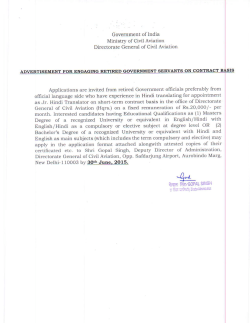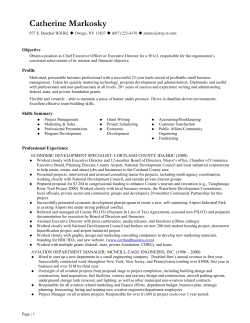
GA Leaflet: Safety Analysis - EASA
FLYING IN THE EU: SAFETY ANALYSIS For General Aviation The Importance of Safety Analysis to Support Decision Making in General Aviation So why is safety analysis so important to GA? Over 1200 General aviation accidents occur every year in Europe alone. Of those accidents, 200 have tragically involved fatalities. The aim of safety analysis is to identify risks and safety issues which can then be used to identify the right safety improvement actions. The traditionally held view is that improving safety in GA is achieved by introducing more rules and regulations. However with better safety data the analysis process is also able to identify more informal solutions such as more-focussed training and safety promotion. At the same time, more knowledge on safety risks in GA will also help to actually reduce the regulatory burden and targeted safety initiatives based on risk assessment. EASA is passionate about aviation and the Agency’s goal is to keep pilots in the air with as few accidents as possible, whilst accepting the fact that safety level in GA can and should never be compared directly to that in Commercial Aviation for fare pay passenger. EASA has therefore initiated the GA Roadmap to simplify rules and reduce costs which might be a burden for the GA community. The purpose of this document is to highlight the important role of safety analysis in achieving the GA Roadmap. Why do we need to collect safety data? • Good data ensures • Best possible decision making • Enables trend monitoring Good safety data is vital to help form the information that is needed to make the best possible decisions and monitor trends. The better the quality of the data and the more information that is available, the more we can understand about the picture of safety risks in GA. Armed with this safety risks picture, people throughout the aviation system can then use this to decide the best ways to mitigate those risks. Rather than leading to more rules and regulations, this improved picture of safety can help to deliver the aims of the GA Roadmap by providing the evidence needed to help reduce the regulatory burden and find different ways to improve safety. Safety promotion will be a key activity that can help us to provide the different parts of the GA community with information to help reduce accidents. There are 2 specific challenges in improving the understanding of safety risks in GA: • • Firstly, how do we use the vast amount of safety data that is already available to better identify safety risks in the different domains of aviation? Secondly, how do we collect information on the operations of the GA sector more effectively with placing too much of a burden on pilots or aircraft owners? 2 Simplified Safety Reporting for GA • • • • Occurrence reporting made simple Simple report form Online reporting Mobile app for reporting When it comes into force in November 2015, Regulation (EU) 376/2014 on the reporting, analysis and follow up of occurrences in civil aviation will lead to significant improvements in the way the GA community reports occurrences to their National Aviation Authorities. Currently, every country has their own occurrence reports, which are not always tailored to the less complex operating environment of GA. The regulation will lead to the introduction of a single, pan-European occurrence report specifically designed just for the GA community. This GA Occurrence Report will be available through a single European Occurrence Reporting Portal, which will then enable pilots to complete reports either on-line or via a downloadable form. The Report will be made available in local languages and would be provided from the portal directly to the relevant National Aviation Authority (not to EASA). The form itself is designed to be as simple as possible, enabling a pilot to provide the maximum amount of information in the shortest possible time. In the longer term, it is anticipated that the GA Occurrence Report would also be made available to pilots through Mobile Apps, making the process of reporting even more simple and anonymous. 3 Implementation of Just Culture • Just culture • Encourages a better environment for the reporting of mistakes One of the greatest concerns raised by pilots is what happens when they submit an occurrence report to their National Aviation Authority. There is often the perception that submitting a report is a bad thing to do because it might result in the Authority taking some kind of action against the pilot. In order to develop a culture where pilots are happy to report occurrences safe in the knowledge that it will be used on for the purposes of safety the implementation of Regulation (EU) 376/2014 also includes provisions to protect the confidentiality of people who report occurrences. The Regulation will also lead to the development of Just Culture policy framework for Europe that will provide both aviation organisations and National Aviation Authorities with guidelines on how to ensure that people who report occurrences are protected. The Just Culture framework is being developed over the coming months with specific involvement of the aviation community. This Just Culture framework will be a key part of establishing a culture where pilots can feel confident in reporting occurrences without action being taken against them when they have made every effort to follow the rules and do the right thing. The Need for Additional Information? • Accident data alone is not enough • Flight hours and number of flights will help to provide more context to the safety picture of GA Just collecting information on accidents and other safety occurrences doesn’t provide all the information that is needed to support the goals of the GA Roadmap. The number of accidents vary from year to year and from country to country. The safety management process for GA requires contextual information on the usage of aircraft to help us to see beyond the number of occurrences to understand, for example, whether an increase in accidents is caused by a reduction in safety or just a natural product of people flying more. It is therefore important that we find a way for the GA community to safely and anonymously report the use of their aircraft. Collecting this information would not be done for any other purposes other than helping us to deliver the goals of the GA Roadmap and to provide the GA community and the EASA MS with a monitoring tool which helps maintaining highest possible safety standard while aiming for simpler rules and lower the cost per flight hour. 4 Using the Information Collected to Improve Safety • New Safety Analysis Process • Involves the GA Community • Provides a partnership in the identification of Safety Issues and solutions As previously mentioned, a great deal of information is already collected from the GA community and this will be made even easier through the implementation of Regulation (EU) 376/2014. There is likely to be a need to capture more information on the usage of aircraft but this will provide the vital information needed to target safety improvement actions in the right areas instead of increasing the regulatory burden. But how will we use this information as part of the Safety Management for GA. There will be much greater involvement of the GA community in the identification of safety risks and the development of potential solutions. EASA are in the process of establishing Coding and Analysis Groups (CAGs) for each GA domain to bring together regulators and members of each community (flying clubs and bodies etc.) to analyse occurrences and help decide on what the information is really telling us. Who better to tell us about the risks of flying that the pilots themselves? 5 So What Can You Do? As individual pilots, there are a number of things that you can do to help improve the understanding of Safety Risks and to help deliver the goals of the GA Roadmap. • • • If you have a safety related incident – please report it to your civil aviation authority as every occurrence will help to build up the safety picture. When you report an occurrence, the more information you provide the better the safety picture will be. There will be a need to provide information on aircraft usage – please help us in this task as it will be very important to the success of the GA Roadmap – we will make the collection of information as easy as possible. European Aviation Safety Agency Ottoplatz, 1 D-50679 Cologne, Germany easa.europa.eu/ga An Agency of the European Union 6
© Copyright 2025













